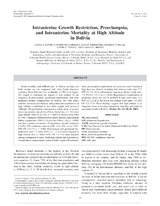Mostrar el registro sencillo del ítem
Intrauterine growth restriction, preeclampsia, and intrauterine mortality at high altitude in Bolivia
| dc.contributor.author | Keyes, LE | |
| dc.contributor.author | Armaza, Fernando | |
| dc.contributor.author | Niermeyer, Susan | |
| dc.contributor.author | Vargas, Enrique | |
| dc.contributor.author | Young, David A | |
| dc.contributor.author | Moore, Lorna G | |
| dc.date.accessioned | 2017-02-15T16:07:26Z | |
| dc.date.available | 2017-02-15T16:07:26Z | |
| dc.date.issued | 2003-02-18 | |
| dc.identifier.uri | http://repositorio.umsa.bo/xmlui/handle/123456789/9687 | |
| dc.description.abstract | Abstract. Infant mortality and stillbirth rates in Bolivia are high and birth weights are low compared with other South American countries. Most Bolivians live at altitudes of 2500 m or higher. We sought to determine the impact of high altitude on the frequency of preeclampsia, gestational hypertension, and other pregnancy-related complications in Bolivia. We then asked whether increased preeclampsia and gestational hypertension at high altitude contributed to low birth weight and increased stillbirths. We performed a retrospective cohort study of women receiving prenatal care at low (300 m, Santa Cruz, n = 813) and high altitude (3600 m, La Paz, n = 1607) in Bolivia from 1996 to 1999. Compared with babies born at low altitude, high-altitude babies weighed less (3084 ± 12 g versus 3366 ± 18 g, p < 0.01) and had a greater occurrence of intrauterine growth restriction [16.8%; 95%confidence interval (CI): 14.9-18.6 versus 5.9%; 95% CI: 4.2-7.5; p < 0.01]. Preeclampsia and gestational hypertension were 1.7 times (95% CI: 1.3-2.3) more frequent at high altitude and 2.2 times (95% CI: 1.4-3.5) more frequent among primiparous women. Both high altitude and hypertensive complications independently reduced birth weight. All maternal, fetal, and neonatal complications surveyed were more frequent at high than low altitude, including fetal distress (odds ratio, 7.3; 95% CI: 3.9-13.6) and newborn respiratory distress (odds ratio, 7.3; 95% CI: 3.9-13.6; p < 0.01). Hypertensive complications of pregnancy raised the risk of stillbirth at high (odds ratio, 6.0; 95% CI: 2.2-16.2) but not at low altitude (odds ratio, 1.9; 95% CI: 0.2-17.5). These findings suggest that high altitude is an important factor worsening intrauterine mortality and maternal and infant health in Bolivia. | es_ES |
| dc.language.iso | en | es_ES |
| dc.publisher | PEDIATRIC RESEARCH | es_ES |
| dc.subject | RESTRICCIÓN CRECIMIENTO INTRAUTERINO | es_ES |
| dc.subject | PREECLAMPSIA | es_ES |
| dc.subject | MORTALIDAD A GRAN ALTURA | es_ES |
| dc.subject | BOLIVIA | es_ES |
| dc.title | Intrauterine growth restriction, preeclampsia, and intrauterine mortality at high altitude in Bolivia | es_ES |
| dc.type | Article | es_ES |

